External plumbing and sewage disposal system: what needs to
Before proceeding with the installation of external communications, it should be remembered that the requirements for them contain a building code for external plumbing and sewage. Failure to comply with its requirements may disrupt the ecological balance at the site, lead to the penetration of wastewater into the soil and contamination of the aquifer. In addition, the system itself can quickly fail.
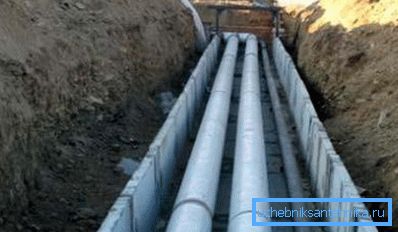
Documents regulating the installation of external networks
The main document according to which the installation of the external plumbing is carried out is SNiP No. 3.05.04 / 85.
In addition, it is necessary to take into account the provisions of the following collections:
- SNiP №III / 4/80;
- SNiP № 3.01.03 / 84;
- SNiP № 3.01.01 / 85;
- SNiP No. 2.04.02 / 84.
Ready communications should be taken into operation according to SNiP No. 3.01.04 / 87.
According to the norms, water pipes for external plumbing and sewage analogues can be:
- asbestos-cement;
- steel;
- reinforced concrete;
- cast iron;
- ceramic;
- plastic.
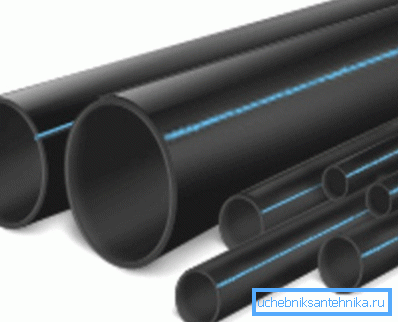
Note! Now, most often used polymeric pipe products. They must be labeled for outdoor installation. Such pipes usually have a black color with a blue stripe.
General requirements for the arrangement of pipelines
According to SNiP № 2.04.02 / 84, the external part of the water supply should have mandatory elements.
Components of the plumbing system
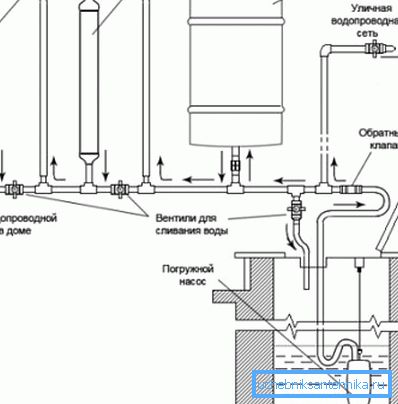
- Water intake facility.
- Pipeline, delivering resource to the entrance to the house.
- Storage tank (water tower).
- An inspection building should be located in front of the pipeline.. When inspection wells are installed on the external water supply, stop valves are mounted in them.
- To increase the pressure (pressure) to the desired value, the system is equipped with a water pumping station.
- Filtration unit, purifying water to the state of drinking.
The joint venture on external water supply systems divides them into the following categories, based on their purpose.
- The household type provides owners with potable water.
- Fire analogue is designed to extinguish fires.
- The production version serves for transportation of technical water. It is used for cooling equipment, manufacturing products, etc.
- Watering species needed for irrigation of plants.
- The circulating type of water supply serves to reduce water consumption.
- Most often the combined network is settled by the hands. It can be used, for example, to water the plants and provide the site with drinking water.
Factors that are taken into account
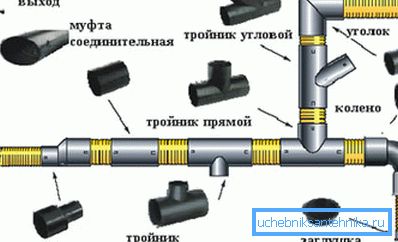
- Laying out the pipes for assembling the network, do not allow the penetration into their surface, waste and groundwater. The products and accessories themselves should not be contaminated.
- Communication is going according to the approved project.
- Trenches before laying pipes should be checked for their compliance with the design dimensions.
- Pipes for free-flow bell-shaped networks should be placed with the extended end towards the water flow.
- On straight stretches, you need to constantly monitor the straightness of the network installation.
- The instruction recommends communications laid from metal pipes to be treated with an anti-corrosion compound.
Network configuration
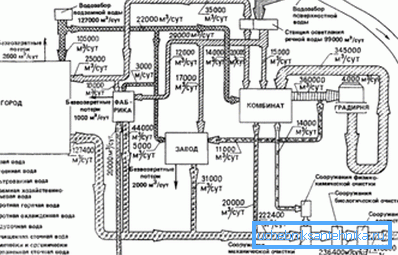
- The trench should be dug from the water intake, below the soil freezing level, at least 20 cm.
- In the inspection of the well shut-off valves are installed for outdoor plumbing. Their diameter and type must be specified in the specifications.
Note! If the system will be connected to a common communal water supply system, it is best to entrust its tie-in to Vodokanal employees. Wiring inside the house can be done independently.
- The minimum slope of the external water supply should be 3 cm for each meter, in the direction of the water intake.
- The minimum cross-section of pipes for street sewage standards set on the basis of its type. If this is a complete separate household network - 200 mm, if the all-rain storm system is 250 mm.
The diameter of the outdoor water pipes is determined on the basis of water consumption, as well as the hydraulic resistance of all segments of the system.
In this case, the minimum diameter of the external water supply is:
- for a utility network in large settlements, as well as industrial facilities - 100 mm,
- in rural areas - 75 mm.
- If the building is multi-storey - 150/200 mm.
Mutual arrangement of engineering networks

- When parallel laying pipes, water supply and sewage should be located with an interval of at least 40 cm.
- It is strictly forbidden to install a sewer network in the area of sanitary water supply.
- When you cannot do without crossing the systems, pipes should be laid at an angle straight to each other. Crossing them at an acute angle is prohibited. At the same time it is necessary to observe the slope of the external water supply.
- Water pipes should be placed above the sewage counterparts. Where they intersect, the vertical gap between them should be at least 0.4 m.
- If plastic pipes are used for installation of systems, they are protected by steel casings at the intersection sites. The length, and hence the price of these elements, is dependent on the type of soil. If it is clay, the length of the casing should be 5 m in both directions from the point of intersection. In a strongly filtering ground (for example, sandy), the figure increases to 10 m.
- The gap between the entrance of sewer and water pipes into the building must be at least 1.5 m.
Conclusion
Constructing outdoor communications, you should adhere to building rules and regulations. They are contained in SNiPs, these documents must be studied before work.
The video in this article contains much more useful.